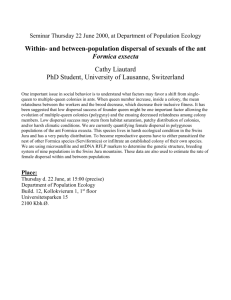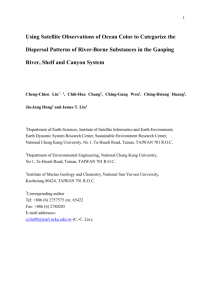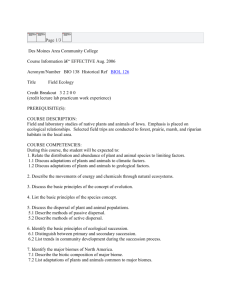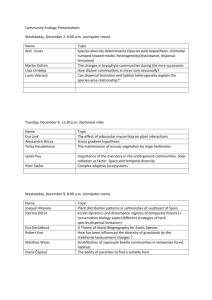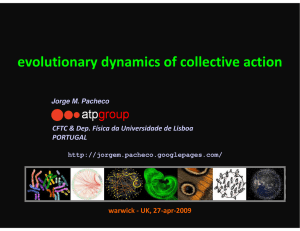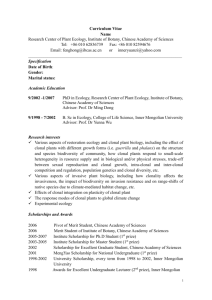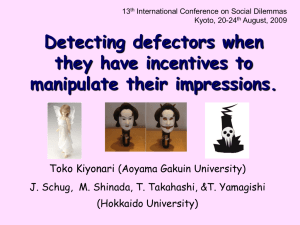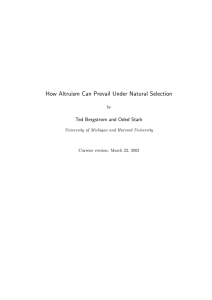Transitions in Individuality via the Reproductive
advertisement
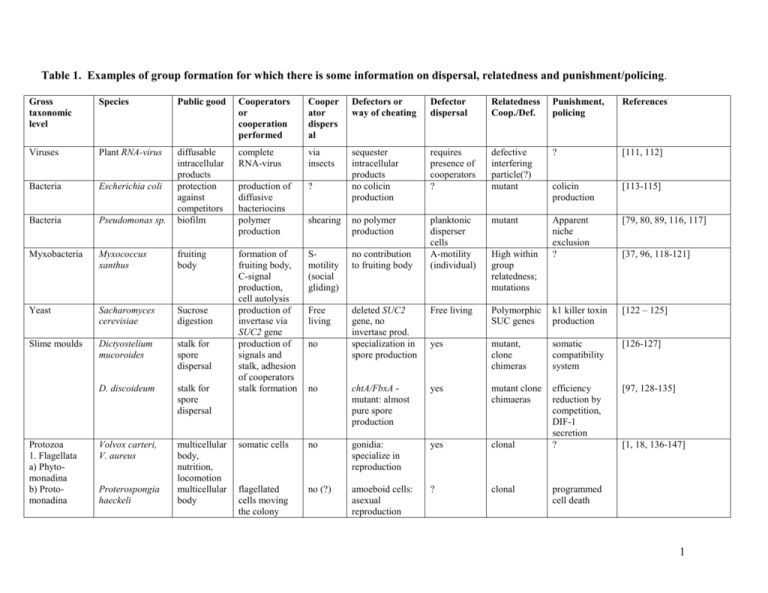
Table 1. Examples of group formation for which there is some information on dispersal, relatedness and punishment/policing. Gross taxonomic level Species Public good Cooperators or cooperation performed Cooper ator dispers al Defectors or way of cheating Defector dispersal Relatedness Coop./Def. Punishment, policing References Viruses Plant RNA-virus complete RNA-virus via insects ? defective interfering particle(?) mutant colicin production [113-115] Bacteria Pseudomonas sp. production of diffusive bacteriocins polymer production requires presence of cooperators ? [111, 112] Escherichia coli sequester intracellular products no colicin production ? Bacteria diffusable intracellular products protection against competitors biofilm shearing no polymer production mutant Myxococcus xanthus fruiting body Smotility (social gliding) no contribution to fruiting body Yeast Sacharomyces cerevisiae Sucrose digestion Free living Polymorphic SUC genes k1 killer toxin production [122 – 125] Dictyostelium mucoroides stalk for spore dispersal deleted SUC2 gene, no invertase prod. specialization in spore production Free living Slime moulds yes mutant, clone chimeras somatic compatibility system [126-127] D. discoideum stalk for spore dispersal formation of fruiting body, C-signal production, cell autolysis production of invertase via SUC2 gene production of signals and stalk, adhesion of cooperators stalk formation Apparent niche exclusion ? [79, 80, 89, 116, 117] Myxobacteria planktonic disperser cells A-motility (individual) no chtA/FbxA mutant: almost pure spore production yes mutant clone chimaeras [97, 128-135] Volvox carteri, V. aureus multicellular body, nutrition, locomotion multicellular body somatic cells no gonidia: specialize in reproduction yes clonal efficiency reduction by competition, DIF-1 secretion ? flagellated cells moving the colony no (?) amoeboid cells: asexual reproduction ? clonal Protozoa 1. Flagellata a) Phytomonadina b) Protomonadina Proterospongia haeckeli no High within group relatedness; mutations [37, 96, 118-121] [1, 18, 136-147] programmed cell death 1 2. Euciliata Peritricha Porifera Zoothamnium arbuscula Spongilla lacustris, Ephydatia sp., Reniera sp., Haliclona sp. Hydractinia spp. multicellular colony multicellular body, care for gametes & embryos feeding zooids, nutrition up to 14 different cell types, various functions nutrition, protection Anthopleura elegantissima nutrition, protection Bryozoa Dendrobeania murrayana nutrition, protection gastrozooids, dactylozooids, tentaculozooid s scout, warrior and free-edge polyps various zooids Urochordata Botryllus schlosseri Insecta Drosophila melanogaster, D. simulans Mus musculus gonads & somatic organs eggs Coelenterata Mammalia eggs no if dissocia ted or as gemmul es no no no macrozooids: no feeding gamete production yes clonal (?) ? [148] yes clonal or chimeric allorecognition restraining exploitation after fusion [56, 149-155] gonozooids (♂+♀): no feeding and defence pure reproductive functions gonozooids production of dispersing gametes clonal partner rejection [156-160] production of dispersing gametes production of dispersing gametes yes clonal ? [161, 162] distinct cell lineages gametic cell competition [24, 167-170] genetic suppression of meiotic drive mitigating effect of other genes [171-174] diploid siblings haplodiploid sisters ? [178, 179] ? [180-184] clonal primordial somatic cells no primordial germ cells wild-type sperm (fair meiosis) wild-type sperm (fair meiosis) yes segregation distortion yes one gene difference yes transmission ratio distortion by t haplotypes yes gene complex diff. on chromos. 17 [163-166] [175-177] Analogies in higher Metazoan communities Isoptera Thysanoptera Aphidae Hymenoptera Cryptotermes secundus Oncothrips habrus, O. tepperi Pemphigus spyrothecae, P. obesinymphae Apis mellifera nutrition, protection gall workers, soldiers micropterous soldiers no reproductives yes no macropterous reproductives yes gall soldiers partly mixed clones ? [185-188] workers no defence, accelerated development reproductives, egg-laying as adult sexuparae nutrition, protection as asex. virginop arae no queens yes, workers no haplodiploid sisters by workers [189-193] 2 Meliponini Pisces Neolamprologus pulcher Aves Corcorax melanorhamphos Mammalia Heterocephalus glaber, Cryptomys damarensis production of highly related females protection group membership, recruitment of allies group membership, protection mother queen (singly mated) no breeders and brood care helpers breeders and brood care helpers low breeders and nonreproductives no conditio nal workers daughter queens (own reprod. lowering colony relatedness) reproductive parasitism by mature helpers deceptive brood care dispersive morph saves effort and accumulates reserves yes motherdaughter by workers [194, 195] high very low expulsion [25, 27, 28, 87, 196-199] conditional usually high aggression by group members [200-204] yes high queen punishment of lazy workers [32-34, 36, 205-210] The public good is the action of cooperators, while defectors do not contribute to the public good. The cooperators or the cooperation performed, and the defectors or their way of cheating, are listed together with information about their respective dispersal, the relatedness between cooperators and defectors, and information about potential coercion in the form of punishment or policing. Note that due to difficulties in obtaining equivalent functional assessments of public goods and dispersal across examples, we considered the former to be a behavior resulting in a potential benefit for one or more group members, and the latter to be movement away from the group. Stricter criteria would be necessary for a more conclusive comparison with model predictions, and thus our objective is to highlight possible similarities and differences, based on first approximations for these complex processes. Question marks denote where respective information is unknown. 3 4
